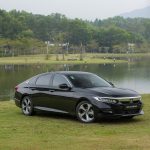With the slogan “Building a car for everyone, for the world”, Honda has responded to the evolving needs of the era by introducing the Civic – an innovative car that brings new value to customers worldwide.
>> Discover the design technology of the Honda Civic
>> Honda Civic officially enters the Vietnamese market
>> New Honda Civic offers more convenience, surpassing the old Civic
>> Honda Civic 2012: Impressive figures
Over its 40-year history spanning 9 generations, Honda Civic has sold 21 million cars worldwide and has won over 60 prestigious international awards for the Japanese car manufacturer. So, what factors have contributed to the success of the Civic? Let’s delve into the history of this car from 1972.
First generation: 1972-1979
The first-generation Honda Civic was produced in 1972 and rolled out in 1973 with a 4-cylinder engine, generating 50 horsepower. At that time, the Civic was available in coupe, three- or five-door hatchback, and five-door station wagon models.
The first-gen FF 2-box Civic positioned Honda as a leading car manufacturer, earning numerous awards such as the “Car of the Year in Japan” presented by Motor Fan Magazine. On a global scale, the Civic bagged the third spot in the “Car of the Year” award in Europe – the highest standing achieved by a Japanese car at that time. It also secured the “Car of the Year 1974” title from Road Test magazine in the United States for imported cars.
Second generation: 1979-1983
With the goal of developing “a high-quality car reflecting the accomplishments of the 80s”, Honda thoroughly re-engineered the Civic in 1979, delivering enhanced economic efficiency and a comfortable experience for drivers and passengers. This enhancement served as a foundation for further advancements in 1980 with the CVCC-II engine, which significantly boosted fuel efficiency.
In 1981, Honda introduced the Civic Country wagon and the four-door Civic sedan, marking a shift towards an overhead transmission system. This modern Civic model earned the “Import Car of the Year 1980 in the United States” accolade from Motor Trend magazine.
Third generation: 1983-1987
The third-generation Civic made its debut in September 1983 and was named the Acura Integra in the US and Canada markets.
The motto of the third-gen Civic was “maximum space for occupants and minimum for equipment”. In line with this mantra, Honda developed 3-door, 4-door, and 5-door Civic models, including a 3-door hatchback, a 4-door sedan, and a 5-door shuttle featuring incredibly spacious interiors. In 1984, the company unveiled the distinctive Civic Si equipped with a DOHC engine built using cutting-edge technology utilized in Formula 1 cars.
The car quickly gained popularity due to its sleek design featuring a long hood and clinched the “Car of the Year in Japan” award in 1984. In the US, this Civic topped the 1984 US Environmental Protection Agency fuel efficiency test for the second consecutive year. In Europe, the same model secured the “1984 Torino-Piedmonte Design Award”.
Fourth generation: 1987-1991
The improvement team behind the fourth-gen Civic prioritized the criterion of “prioritizing user experience”. To achieve even higher efficiency, Honda introduced the Hyper 16-valve engine encompassing 5 different variants ranging from 1,300cc to 1,500cc. Users could find everything they desired in a car thanks to the four-wheel double wishbone suspension system.
In 1989, Honda unleashed the Civic SiR featuring a high-performance DOHC VTEC engine, revolutionizing valve adjustment technology. This innovation clinched the “Golden Steering Wheel” award from the German newspaper Bild am Sonnntag and secured the top position in a 1989 survey on car quality and reliability conducted by France’s L’Automobile magazine.
Fifth generation: 1991-1995
The fifth-gen Civic hit the market in September 1991, boasting increased dimensions and a more aerodynamic design.
The most notable feature of the fifth-gen Civic was its futuristic design and a comfortable interior space tailored to the specific needs of young individuals. This new model foreshadowed the advent of VTEC engines, providing outstanding vehicle performance and high fuel efficiency. These engines included a 170-horsepower DOHC VTEC engine, a super fuel-efficient VTEC-E engine, and a high-balanced VTEC engine. These new models showcased remarkable progress in terms of environmental and human friendliness, along with advanced safety features and high replaceable parts rates. The fifth-gen Civic secured the “Car of the Year in Japan” award in both 1991 and 1992.
Sixth generation: 1995-2000
The sixth-gen Civic made its debut in 1996, featuring wider headlamps, a grille, and distinctive body lines.
Unlike its predecessors, which catered to the general public, the sixth-gen Civic became a quintessential means of transportation, addressing the needs of each era on a global scale. The car epitomized the fusion of cutting-edge technologies to satisfy demands for high-performance, high-safety, and low-emission capabilities. These innovative technologies included 3-stage VTEC engines providing ample power and fuel efficiency, as well as Honda Multimatic transmissions – the next-generation transmission system boasting high variability. With these phenomenal advantages, the sixth-gen Civic clinched the “Car of the Year in Japan” award in both 1995 and 1996.
Seventh generation: 2000-2005
Honda showcased the seventh-gen Civic to fulfill all crucial criteria, encompassing maximum cabin space, optimal fuel efficiency, and a comfortable driving experience. Moreover, the seventh-gen Civic prioritizes safety for both occupants and pedestrians. The expansive interior space is made possible by the low, flat vehicle floor design, allowing effortless mobility between front and rear seats.
The seventh-gen Civic adhered to the highest safety standards and earned the “Car of the Year in Japan” award in both 2001 and 2002.
Eighth generation: 2005-2011
On September 22, 2005, Honda Japan unveiled the eighth-gen Civic to the media. The 1.8L engine variant epitomizes a new generation of mid-range sedans, boasting improved powerful features and fuel efficiency.
This new version flaunts a bold design characterized by a wider distance between wheels, translating into a more spacious interior.
Ninth generation: 2011-present
The ninth-gen Honda Civic was officially introduced to the US market at the onset of 2011, carrying the high expectations of the Japanese car manufacturer due to the immense success and popularity of its predecessor, the compact Civic, among American consumers.
However, upon its initial release, the 2012 Civic faced criticism for its lack of standout features and similarities to the previous version. Moreover, just 6 months later, the 2012 Civic encountered a major setback when it was heavily criticized by the reputable Consumer Reports magazine for its subpar interior quality, excessive noise levels, and lack of agility, leading the publication to assert that the Civic 2012 would struggle to compete in the compact car segment.
Most recently, in early August 2012, Consumer Reports once again listed the Civic 2012 among the 5 recommended cars not to buy for the same reasons documented previously.
Nevertheless, the new-gen Honda Civic endeavored to prove itself despite the criticisms. As time went on, the new-gen Civic has substantiated its worth by emerging as the best-selling model in the compact segment of the US market during the first 7 months of 2012. Furthermore, the Civic 2012 consistently ranks among the top 10 best-selling cars in the US market on a monthly basis.
The success achieved by the Civic 2012 unequivocally rebuts Consumer Reports’ evaluation, indicating that the publication has set higher standards for the new-generation Civic.
TTTÐ (Information Technology and Telecommunications Training Center)







































![[USER REVIEW] Honda Civic RS: Stylish, Premium, and Alluring](https://vnauto.net/wp-content/uploads/2023/10/xehay-hondacivicrs-08042023-2-150x150.jpg)

![[CAR REVIEW] Introducing the brand new 2022 Honda HR-V: A complete transformation from the inside out](https://vnauto.net/wp-content/uploads/2023/11/xehay-hondahrv-15062022-2-150x150.jpg)
![[Car Review] All-new Honda HR-V 2022: The Perfect Urban Crossover for Young Buyers](https://vnauto.net/wp-content/uploads/2023/11/xehay-hondahrv-08082022-1-150x150.jpg)












